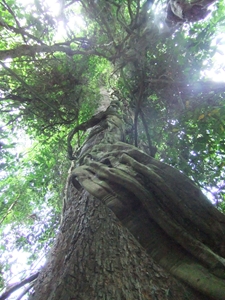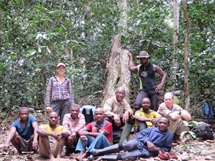Ghana
- January 2009 - April 2010

Between January 2009 and December 2010 Sophie Fauset led over 9 months of fieldwork in the forests of Ghana. The work was carried out as part of the Afritron network, with funding from the Royal Society and in collaboration with the Forestry Commission of Ghana, though Kofi Affum-Baffoe, and Forestry Research Institute of Ghana (FORIG), through Ernest Foli. Armed with maps of plot locations that had been established by the Forestry Commission in the early 1990s, Sophie and the team (Kwaku Duah, Yaw Nkrumah and Afedo Godwin) endeavoured to search them out and remeasure plots along a rainfall and fire disturbance gradient. Whilst finding 20 year old plots without GPS co-ordinates was a challenge, the team was able to find and recensus 25 1 ha plots from 9 forest reserves. This included occasionally using psychic powers to guess where the plot would be, and it actually being there! All trees and lianas > 10 cm diameter were censused, as well as measurements of tree heights and liana loads on a subsample of trees. Soil samples were also collected. Tree species identifications were checked by Jonathan Dabo of FORIG.
The precipitation regime of the the plots ranged from 1200 – 2200 mm mean annual precipitation. Since the early 1970s, rainfall in the region decreased approx. 10 %. Given this, we were able to investigate the impact of a long-term, low intensity drought on forest structure and composition. 10 of the plots included had been unintentionally burnt in 1983, and the data collected will be used to assess the extent of regeneration of burnt plots. The intensity of burning varied across the plots. Some plots appeared similar to unburnt forest. However, the most intensely burnt forests clearly had fewer trees and lower biomass. In some cases, the fire had allowed exotic species to invade, such as a herbaceous weed Chromolaena odorata, and a tree Broussonetia papyrifera that had originally been introduced to Ghana in plantations for pulp production. The presence of such invasive species may suppress forest regeneration from disturbed conditions.

















